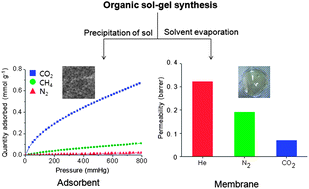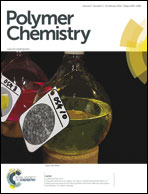Polyurea networks via organic sol–gel crosslinking polymerization of tetrafunctional amines and diisocyanates and their selective adsorption and filtration of carbon dioxide†
Abstract
Organic molecular networks were synthesized via organic sol–gel polymerization of tetrakis(4-aminophenyl)methane with various alkyl diisocyanates. Colloidal dispersions of nanoparticulate molecular networks were obtained by controlling monomer combinations and concentrations, which enabled liquid phase processing of the covalent networks into desired forms of materials. Pouring the sols into a non-solvent yielded nanoparticulate networks that showed highly selective adsorption for CO2 over N2 or CH4. Free-standing films of the network material were prepared by evaporation of the sols. The membranes exhibited unusual reverse-selective transport characteristics with lower permeability to CO2 than to N2. This is the first example of gas separation membranes directly prepared from the liquid phase of covalent molecular networks. The organic sol–gel chemistry of covalent molecular networks is promising for the development of new functional adsorbents and membranes because it will enable exploitation of intrinsic microporosity of molecular networks.


 Please wait while we load your content...
Please wait while we load your content...